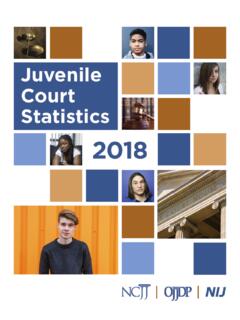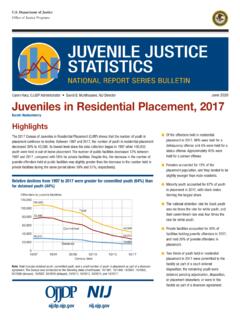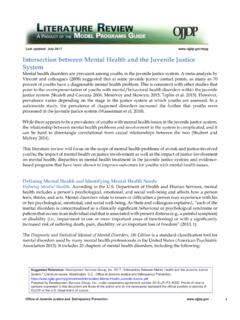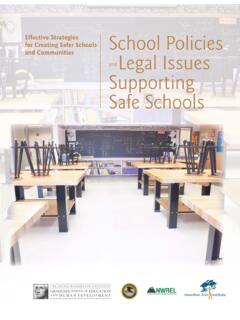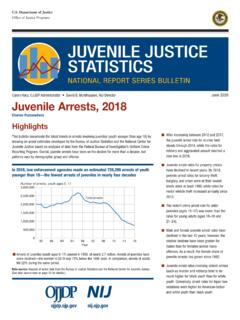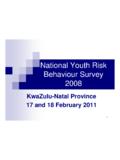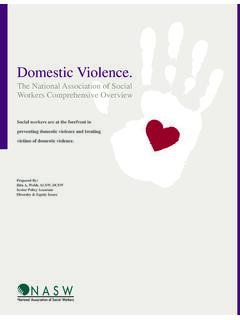Transcription of Children’s Exposure to Violence, Crime, and Abuse: An Update,
1 Department of JusticeOffice of Justice ProgramsOffice of Juvenile Justice and Delinquency Prevention A Message From OJJDPC hildren are exposed to violence every day in their homes, schools, and communities. Such Exposure can cause them significant physical, mental, and emotional harm with long-term effects that can last well into Attorney General launched Defending Childhood in September 2010 to unify the Department of Justice s efforts to address children s Exposure to violence under one initiative. Through Defending Childhood, the Department is raising public awareness about the issue and supporting practitioners, researchers, and policymakers as they seek solutions to address it. A component of Defending Childhood, OJJDP s Safe Start Initiative continues efforts begun in 1999 to enhance practice, research, training and technical assistance, and public education about children and violence.
2 Under Safe Start, OJJDP conducted the National Survey of Children s Exposure to Violence, the most comprehensive effort to date to measure the extent and nature of the violence that children endure and its consequences on their lives. This is the first study to ask children and caregivers about Exposure to a range of violence, crime , and abuse in children s amply evidenced in this bulletin series, children s Exposure to violence is pervasive and affects all ages. The research findings reported here and in the other bulletins in this series are critical to informing our efforts to protect children from its damaging OJJDP publications online at Learn more about the Attorney General s Defending Childhood Initiative at Find out more about OJJDP s Safe Start Initiative on the Safe Start program summary page at Children s Exposure to ViolenceNATIONAL SURVEY OFChildren s Exposure to ViolenceOffice of Justice ProgramsInnovation Partnerships Safer Neighborhoods L.
3 Listenbee, Administrator September 2015 Children s Exposure to Violence, crime , and Abuse: An Update David Finkelhor, Heather Turner, Anne Shattuck, Sherry Hamby, and Kristen Kracke This bulletin discusses the second National Survey of Children s Exposure to Violence (NatSCEV II), which was conducted in 2011 as a followup to the original NatSCEV I survey. The Department of Justice (DOJ) and the Centers for Disease Control and Prevention (CDC) sponsored both surveys. The Crimes against Children Research Center of the University of New Hampshire conducted the NatSCEV I survey between January and May 2008. NatSCEV I represented the first comprehensive national survey of children s past-year and lifetime Exposure to violence, crime , and abuse in the home, school, and community across children and youth from ages 1 month to 17 years.
4 (For more information on NatSCEV I, see History of the National Survey of Children s Exposure to Violence ). As in the first NatSCEV survey, NatSCEV II researchers interviewed a nationally representative sample of children and their caregivers regarding the children s Exposure to violence, crime , and abuse across several major categories: conventional crime , child maltreatment, victimization by peers and siblings, sexual victimization, witnessing and indirect victimization (including Exposure to community violence, family violence, and school violence and threats), and Internet victimization. (For more detailed information on the types of violence that children were questioned about in NatSCEV I, see Finkelhor, Turner, Ormrod, Hamby, and Kracke, 2009). In addition to the types of Exposure to violence, crime , and abuse covered in the original survey, NatSCEV II asked participants about several new types of Exposure in the categories of conventional crime , child maltreatment, peer and sibling victimization, and Internet victimization (see Methodology ).
5 In general, NatSCEV II confirms the earlier survey s findings regarding the extent of children s past-year and lifetime Exposure to violence, crime , and abuse, with few significant changes in reported exposures between the two surveys. In the NatSCEV II sample, approximately three in five children ( percent) experienced at least one Exposure to five aggregate types of violence in the past year (physical assault , sexual victimization, maltreatment, property victimization, and witnessing violence). Among the individual categories of Exposure , declines somewhat outnumbered increases; however, NatSCEV II recorded significant changes from 2008 (all declines) in Exposure to only 6 of 54 types of Exposure to violence covered in the survey (see Methodology ): property victimization and robbery (past year), being flashed by a peer (past year and lifetime), statutory sex offenses (past year and lifetime), school bomb threats (past year and lifetime), and assault by juvenile siblings (lifetime).
6 NatSCEV II recorded high levels of past-year Exposure to various individual categories of direct victimization. In 2011, approximately 2 in 5 children and youth surveyed ( percent) were victims of at least one assault in the past year, and approximately 1 in 10 ( percent) were injured in an assault . Approximately 1 in 20 children and youth ( percent) were sexually victimized in the past year. Approximately one in four children and youth ( percent) were victims of property crimes (including robbery, vandalism, and theft) in the past year. The reported rate of child maltreatment (including physical, sexual , and emotional abuse; neglect; and custodial interference or family abduction) in the past year was percent. Approximately 1 in 4 study participants witnessed a violent act in the past year ( percent), and approximately 1 in 12 witnessed family violence in the past year ( percent).
7 Approximately 1 in 30 children and youth ( percent) experienced bomb or attack threats against their schools. The rate of indirect Exposure to household theft was percent in the past year. Multiple exposures to violence among children and youth continued to be a concern, with nearly one-half ( percent) of NatSCEV II participants reporting more than one type of direct or witnessed victimization in the past year nearly 1 in 6 ( percent) reported 6 or more types of direct or witnessed victimization and 1 in 20 ( percent) reported 10 or more types of direct or witnessed victimization over the same period. In 2011, reported rates of lifetime Exposure to violence continued to be high, especially for the oldest youth (ages 14 17), showing how Exposure to violence accumulates as a child grows.
8 For example, approximately 7 in 10 of these youth ( percent) had been assaulted during their lifetimes, and a similar proportion ( percent) witnessed violence during their lifetimes. In addition, more than half of these youth ( percent) were victims of property crimes during their lifetimes. Lifetime Exposure to major categories of violence for all youth surveyed in 2011 ranged from approximately 1 in 10 ( percent) for sexual victimization to more than half ( percent) for any assault . During their lifetimes, one in four ( percent) were victims of maltreatment, two in five ( percent) were victims of property crimes, and two in five ( percent) witnessed violence. Background Childhood Exposure to violence, crime , and abuse can lead to serious consequences for the health and well being of those exposed, both during childhood and throughout adulthood (Shonkoff, Boyce, and McEwen, 2009; Fang et al.)
9 , 2012). Child maltreatment, peer victimization, and Exposure to family and community violence have all been shown to be connected to developmental difficulties, problem behavior, and physical and mental health effects extending throughout the lifespan (Danese et al., 2009; Sachs-Ericsson et al., 2005; Widom, DuMont, and Czaja, 2007; Bensley, Van Eenwyk, and Wynkoop Simmons, 2003). Children exposed to violence, crime , and abuse are more likely to abuse drugs and alcohol; suffer from depression, anxiety, and posttraumatic stress disorder; fail or have difficulties in school; and become delinquent and engage in criminal behavior. (For a more detailed discussion of the problem of child victimization, see Finkelhor, Turner, Ormrod, Hamby, and Kracke, 2009, and the sources cited therein.
10 Measuring child victimization accurately and comprehensively is crucial to reducing child victimization because those assessments help child welfare professionals identify and provide services to child victims of violence and their families and provide programs to educate children, their families, and those who work with children at risk for violence (including educators, social workers, medical professionals, and juvenile justice professionals). Unfortunately, earlier studies that measured children s Exposure to violence often were limited in the age ranges and types of Exposure to violence studied as well as where the Exposure to violence took place ( , they were limited to violent incidents in the home, the school, or the community instead of studying incidents in all of these locations) (Shonkoff, Boyce, and McEwen, 2009; Finkelhor, 2008; Nansel et al.)

